
Craps is a dice game in which the players make wagers on the outcome of the roll, or a series of rolls, of a pair of dice. Players may wager money against each other or a bank. Because it requires little equipment, "street craps" can be played in informal settings. While shooting craps, players may use slang terminology to place bets and actions.

Yahtzee is a dice game made by Milton Bradley, which was first marketed as Yatzie by the National Association Service of Toledo, Ohio, in the early 1940s. It was marketed under the name of Yahtzee by game entrepreneur Edwin S. Lowe in 1956. The game is a development of earlier dice games such as Poker Dice, Yacht and Generala. It is also similar to Yatzy, which is popular in Scandinavia.
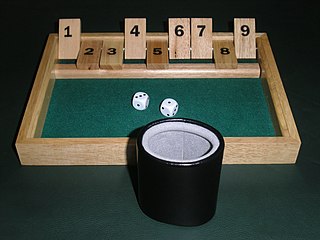
Shut the box, also called Blitz, Canoga, klackers, batten down the hatches, kingoball, trictrac, cut throat, fork your neighbor, and jackpot, is a game of dice for one or more players, commonly played in a group of two to four for stakes. Traditionally, a counting box is used with tiles numbered 1 to 9 where each can be covered with a hinged or sliding mechanism, though the game can be played with only a pair of dice, pen, and paper. Variations exist where the box has 10 or 12 tiles. Alternatively, dominoes can be used for the tiles - this also provides the option of using up to six dice if a Double 18 domino set is used. A deck of cards can also be used as tiles, and if so desired a complete conventional Western deck with the jokers can provide for the use of up to nine dice. As described below under Variants, the dominoes or cards can also be used in place of the dice if so desired.

Pig is a simple dice game first described in print by John Scarne in 1945. Players take turns to roll a single die as many times as they wish, adding all roll results to a running total, but losing their gained score for the turn if they roll a 1.

Bunco is a parlour game generally played with twelve or more players, divided into groups of four, trying to score points while taking turns rolling three dice in a series of six rounds. A Bunco is achieved when a person rolls three-of-a-kind and all three numbers match the round number.
Cee-lo is a gambling game played with three six-sided dice. There is not one standard set of rules, but there are some constants that hold true to all sets of rules. The name comes from the Chinese Sì-Wŭ-Liù (四五六), meaning "four-five-six". In America it is also called "See-Low," "Four-Five-Six," "The Three Dice Game," "Roll-off!," and by several alternative spellings, as well as simply "Dice." In China it is also called "Sān Liù Bàozi" (三六豹子), or "Three-Six Leopards". In Japan, it is known as "Chinchiro" (チンチロ) or "Chinchirorin" (チンチロリン).
Farkle, or Farkel, is a dice game has also been called or is similar to 1000/5000/10000, Cosmic Wimpout, Greed, Hot Dice, Squelch, Zilch, or Zonk. Its origins as a folk game are unknown, but the game dates back to at least the mid 1980s. It has been marketed commercially since 1996 under the brand name Pocket Farkel by Legendary Games Inc. While the basic rules are well-established, there is a wide range of variation in both scoring and play, as described below.
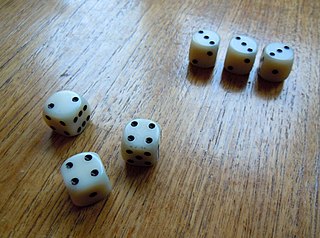
Dice 10,000 is the name of a family dice game, it is very similar to farkle. It also goes by other names, including Zilch, Zilchers, Foo, Boxcar, Bogus, Zach’s Dice Game, and Crap Out.

Pass the Pigs is a commercial version of the dice game Pig, but using custom asymmetrical throwing dice, similar to shagai. It was created by David Moffatt and published by Recycled Paper Products as Pig Mania! in 1977. The publishing license was later sold to Milton Bradley and the game renamed Pass the Pigs. In 2001, publishing rights for North America were sold to Winning Moves Games USA, which acquired the game outright from David Moffat Enterprises in early 2017.
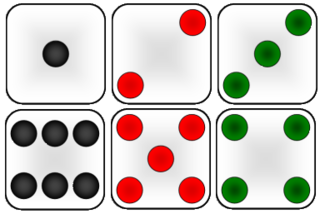
Kismet is a commercial dice game introduced in 1964. The game's name is the Turkish word for "fate". E.William DeLaittre holds the trademark on the game, which was originally published by Lakeside Games, and which is currently produced by Endless Games. Marketed as "The Modern Game of Yacht", the game play is similar to Yacht and Yahtzee, with a few variations. A primary distinction is that in Kismet, the sides of the dice have different colored pips.
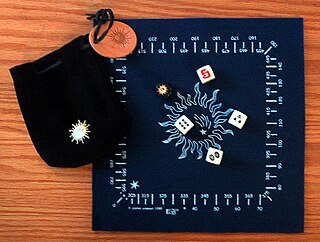
Cosmic Wimpout is a dice game produced by C3, Inc in 1976. It is similar to 1000/5000/10000, Farkle, Greed, Hot Dice, Squelch, Zilch, Zonk, or Darsh to name but a few. The game is played with five custom dice, and may use a combination score board and rolling surface, in the form of a piece of cloth or felt available in various colors and designs. Players supply their own game piece for score keeping.
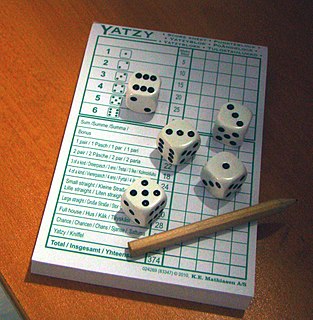
Yatzy is a public domain dice game similar to Yacht and Yahtzee. It is related to the Latin American game Generala and the English game of poker dice. Yatzy is most popular in the Scandinavian countries and Finland.
To Court the King is a dice-based board game for 2–5 players designed by Tom Lehmann. It was published in German by Amigo Spiele as Um Krone und Kragen in 2006, and in English as To Court the King by Rio Grande Games. The basic mechanics of rolling and re-rolling dice have drawn comparisons to the game of Yahtzee.

Generala is a dice game similar to the English game of poker dice, the Polish game Jacy-Tacy (yahtzee-tahtzee) and the American game Yahtzee. Although it is sometimes played in Europe and the United States, Generala is most popular in Iberoamerica.
A number of related games under the Yahtzee brand have been produced. They all commonly use dice as the primary tool for game play, but all differ generally. As Yahtzee itself has been sold since 1954, the variants released over the years are more recent in comparison, with the oldest one, Triple Yahtzee, developed in 1972, eighteen years after the introduction of the parent game.
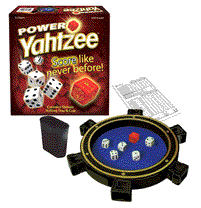
Power Yahtzee is a variation on the classic dice game Yahtzee first published by Winning Moves Games USA in 2007. It includes a sixth multiplier die called a "Power die" and an expanded scoresheet. This game is no longer in production.

Yacht is a public domain dice game, similar to the Latin American game Generala, the English game of Poker Dice, the Scandinavian Yatzy, and Cheerio. Yacht dates back to at least 1938, and is a contemporary of the similar three-dice game Crag. Yahtzee is a later development, similar to Yacht in both name and content.

Crag is a dice game similar to Yacht and Yahtzee. It is played with three dice. The game is quicker to play than Yahtzee, and in Clement Wood and Gloria Goddard's 1940 Complete Book of Games, it is described as a game that "shares with Yacht the supremacy among sequence dice-casting games".

Yamb is a public domain dice game similar to Yacht and Yahtzee.

Kivi is a 2016 abstract strategy board game for two to four players, invented by British Maureen Hiron and Jamaican-born British Sheyla Bonnick.















